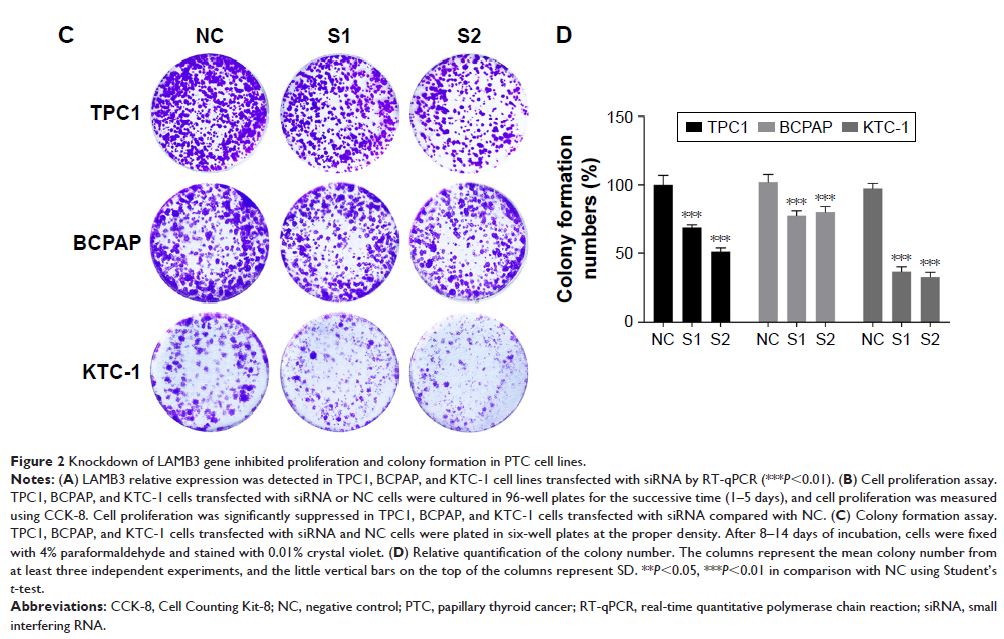9 7 8 1 6
论文已发表
注册即可获取德孚的最新动态
IF 收录期刊
- 3.3 Breast Cancer (Dove Med Press)
- 3.4 Clin Epidemiol
- 2.5 Cancer Manag Res
- 2.9 Infect Drug Resist
- 3.5 Clin Interv Aging
- 4.7 Drug Des Dev Ther
- 2.7 Int J Chronic Obstr
- 6.6 Int J Nanomed
- 2.5 Int J Women's Health
- 2.5 Neuropsych Dis Treat
- 2.7 OncoTargets Ther
- 2.0 Patient Prefer Adher
- 2.3 Ther Clin Risk Manag
- 2.5 J Pain Res
- 2.8 Diabet Metab Synd Ob
- 2.8 Psychol Res Behav Ma
- 3.0 Nat Sci Sleep
- 1.8 Pharmgenomics Pers Med
- 2.7 Risk Manag Healthc Policy
- 4.2 J Inflamm Res
- 2.1 Int J Gen Med
- 4.2 J Hepatocell Carcinoma
- 3.7 J Asthma Allergy
- 1.9 Clin Cosmet Investig Dermatol
- 2.7 J Multidiscip Healthc

上调后的 LAMB3 可增加甲状腺癌的增殖和转移
Authors Wang Y, Jin Y, Bhandari A, Yao Z, Yang F, Pan Y, Zheng Z, Lv S, Wang O
Received 21 August 2017
Accepted for publication 14 November 2017
Published 21 December 2017 Volume 2018:11 Pages 37—46
DOI https://doi.org/10.2147/OTT.S149613
Checked for plagiarism Yes
Review by Single-blind
Peer reviewers approved by Dr Manfred Beleut
Peer reviewer comments 5
Editor who approved publication: Dr Ingrid Espinoza
Background: Thyroid cancer is the most commonly reported endocrine malignancy,
and its increased incidence has been the highest in all human tumors in recent
decades. To investigate the mechanism of papillary thyroid cancer (PTC)
occurrence and progression, we performed RNA sequencing and found an
upregulated gene, LAMB3 . However, the
biological function of LAMB3 is still
not clear.
Materials and methods: We analyzed LAMB3 expression
using The Cancer Genome Atlas (TCGA) database and hypothesized LAMB3 to be a gene associated
with PTC. To test this hypothesis, we collected 89 pairs of thyroid nodules and
adjacent normal thyroid tissues (56 pairs of PTCs, 33 pairs of benign thyroid
nodules). Afterward, we performed real-time quantitative polymerase chain
reaction (RT-qPCR) to investigate LAMB3 expression
in thyroid nodule patients, and then analyzed clinicopathologic features. We
performed proliferation, colony formation, migration, and invasion assays to
determine the function of LAMB3 in PTC.
Results: We demonstrated that LAMB3 plays oncogenic roles
in PTC. The relative expression of LAMB3 is
significantly upregulated in PTC compared with matched thyroid normal tissues
in validated cohort and TCGA cohort (P <0.001). We
also checked area under the curve (AUC of receiver operator characteristic
[ROC]) of 97.3% for validated cohort and 90.1% for TCGA cohort to differentiate
PTC tumors from normal tissues. In clinicopathologic feature analysis, we found
that upregulated LAMB3 is
closely related to lymph node metastasis (P =0.018).
Furthermore, knockdown of LAMB3 inhibited
the proliferation, colony formation, migration, and invasive capacity of PTC.
Conclusion: This study indicated that LAMB3 is a gene associated
with PTC.
Keywords: papillary
thyroid cancer, LAMB3 , PTC
